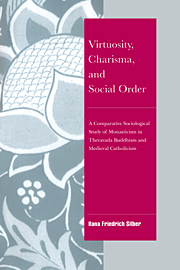 Virtuosity, Charisma and Social Order
Virtuosity, Charisma and Social Order Published online by Cambridge University Press: 09 October 2009
The most remarkable feature of Theravada Buddhism, from the perspective of this study, is that its early scriptures already provided both the notion of a community of virtuosi and a specific model of interaction between virtuosi and laymen. As we shall see, the early doctrinal preoccupation with the relation between virtuosi and laity is itself rooted in a very distinctive mode of coexistence, or “economy,” of otherworldly and worldly orientations within the canonical corpus, combining an extreme world-negating definition of salvation on the one hand with a sustained concern with the social order as the inevitable and even necessary context of this search for salvation on the other.
Theravada Buddhism is known for its conservative concern with the proper preservation and understanding of its canonical texts, and the Pali scriptures did indeed remain a constant source of reference and ideological inspiration throughout the traditional period. Canonical Buddhism, however, is not the only ideological influence to have been at work. Neither did the interpretation of Buddhist doctrines remain static from the time of their early efflorescence in northeast India, through their spread to what became their bastion in Sri Lanka and later diffusion throughout Southeast Asia. Understanding the dynamics of the virtuoso–layman relation on the ideological level will thus also require us to consider a number of later ideological developments that, even if innovative and deviating from canonical premises, became part and parcel of Theravada “orthodoxy.”
To save this book to your Kindle, first ensure no-reply@cambridge.org is added to your Approved Personal Document E-mail List under your Personal Document Settings on the Manage Your Content and Devices page of your Amazon account. Then enter the ‘name’ part of your Kindle email address below. Find out more about saving to your Kindle.
Note you can select to save to either the @free.kindle.com or @kindle.com variations. ‘@free.kindle.com’ emails are free but can only be saved to your device when it is connected to wi-fi. ‘@kindle.com’ emails can be delivered even when you are not connected to wi-fi, but note that service fees apply.
Find out more about the Kindle Personal Document Service.
To save content items to your account, please confirm that you agree to abide by our usage policies. If this is the first time you use this feature, you will be asked to authorise Cambridge Core to connect with your account. Find out more about saving content to Dropbox.
To save content items to your account, please confirm that you agree to abide by our usage policies. If this is the first time you use this feature, you will be asked to authorise Cambridge Core to connect with your account. Find out more about saving content to Google Drive.